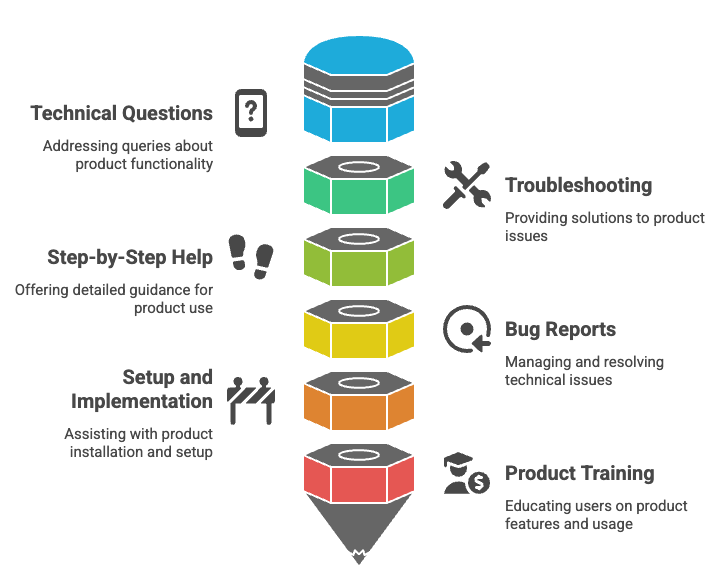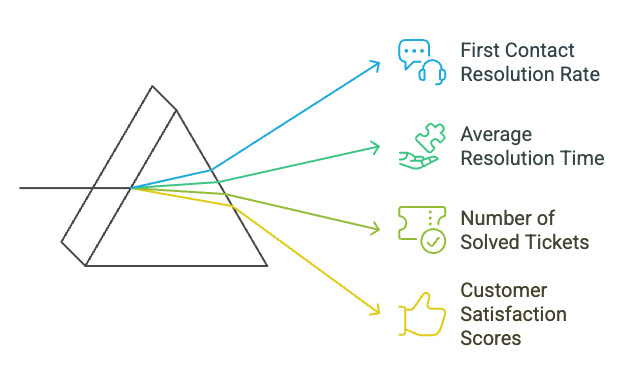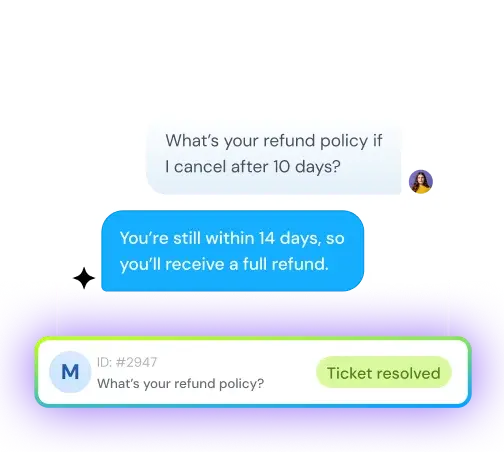Customer service vs. customer support: A complete breakdown
Sep 03, 2025

"Aren't customer support and customer service basically the same thing?"
It’s a genuine confusion everyone has. Well, they’re not the same, yet not so different.
Think about it like this - customer service embraces the entire relationship, while support focuses on solving specific technical problems. It's the difference between nurturing a garden and fixing a broken sprinkler. Both matter immensely.
Your team needs to know the significant differences between customer support and service to provide the right assistance at the right moment. This knowledge proves vital whether you're building a customer-facing team or improving current operations.
Let's explore what makes these functions different and how you can utilize both to improve your customer relationships.
What is customer service?
Customer service goes beyond just helping customers with their problems. Your company's support system works throughout the customer's experience - from initial contact through post-purchase assistance. This vital business function has grown into something much bigger than basic troubleshooting.
Great customer service brings tremendous value to businesses. Here's what the numbers tell us:
- Retention focus: Keeping existing customers satisfied is more cost-effective than acquiring new ones.
- Revenue generation: About 85% of service leaders report their organizations expect them to contribute more to revenue.
- Competitive advantage: Service quality separates your brand when products or services are similar.
- Customer loyalty: Seven out of ten consumers spend more money with companies that deliver outstanding service.
- Financial consequences: U.S. companies lose more than $62 billion annually due to poor customer service.
Quality customer service builds meaningful connections by making interactions personal and spotting needs before they become problems. This approach builds trust, boosts your brand's reputation, and transforms casual buyers into loyal supporters.
Each customer interaction gives your business a chance to build stronger relationships.
What is customer support?
Customer support is different from customer service because it focuses on technical help that customers need to use your products or services well. The support team solves specific technical problems and answers questions about products. They help with troubleshooting, give technical guidance, and make sure products work the way they should.
Your support team jumps in when customers have problems with products or services. They solve specific technical challenges. Support interactions have a clear path - they start with a problem and end with a solution.
Customer support has these key areas:

Teams measure customer support success through:

Customer support is different from customer service because it needs technical knowledge and problem-solving skills.
Support specialists need special training to understand product design, common technical issues, and ways to fix problems. Customer service looks at the customer's whole experience. Support helps with specific technical needs at certain times.
Most support happens after purchase, when customers use products and need help with technical things.
Customer support teams are your technical problem solvers. They give specialized knowledge that helps customers overcome challenges and get the most value from your products or services.
Customer support vs customer service: 10 key differences
Many businesses don't see the difference between customer support and customer service in their daily operations. The difference between these two functions helps companies build better teams and give their customers a better experience.
1. Focus and objectives
When reaching out for customer support, your main goal is to get something fixed. Maybe an issue with your app, your login keeps failing, or there’s a bug that is stopping you from doing your work. Support teams are focused on solving those technical issues as quickly as possible.
But when you interact with customer service, it’s about how you feel during the experience, not just about fixing things. They prioritise trust and loyalty of the customers towards the brand, not just providing answers. Support restores function, service builds connection.
2. Nature of interaction
Think about the last time you called support — it probably started because you spotted a problem and asked for help. That’s support: reactive, problem-focused, and specific.
Now picture service. Service teams might check in after you make a purchase to send tips for you to get the most from the product, instead of waiting for the issues, they also follow up to make sure you are satisfied. Service feels more proactive, like someone is looking out for you even when you don’t ask.
3. Scope of application
If you’re using software or gadgets, you’re likely to deal with support often. These teams step in when products get tricky or too technical for you to figure out on your own.
But no matter what kind of business you interact with — whether it’s your bank, your favorite coffee shop, or an online store — you’ll experience customer service. Service is universal because it’s all about making sure you feel taken care of, no matter what industry it is.
4. Depth of technical knowledge
When you contact support, you expect them to know the product inside out — almost as well as the people who built it. You trust them to dig into technical details, troubleshoot step by step, and get you back on track.
On the other hand, service doesn’t always need that level of technical expertise. What you really want from service reps is empathy, good communication, and an understanding of company policies so they can guide you smoothly. Service is less about fixing code and more about making sure you feel respected and informed.
5. Duration of interaction
Support interactions usually have a clear beginning and end. You call, explain the issue, they fix it, and that’s that. Once the problem is resolved, you both move on.
Service, however, stays with you across your entire journey. From the moment you’re considering a product, through the purchase, and even long after, service plays a role. It’s not just one conversation — it’s an ongoing relationship where you feel supported and valued over time.
6. Problem-solving approach
When you’re stuck with a stubborn issue, support might try multiple solutions before hitting the right fix. They experiment, escalate, or test things until your problem is solved. It can be a bit like detective work.
With service, the questions you ask are usually more straightforward — things like billing, shipping, or policies. These often have clear, standard answers, so service can respond quickly and consistently. That doesn’t mean it’s less important; it just means service is about clarity while support is about technical problem-solving.
7. Performance metrics
When you think of support success, your biggest concern is usually speed and accuracy. You want your issue solved the first time you reach out, and you don’t want to wait days for a resolution. That’s why metrics like First Contact Resolution (FCR) and average resolution time matter so much — they directly affect how quickly your frustration turns into relief.
With service, it’s less about how fast something gets done and more about how you feel afterward. Did the interaction leave you satisfied? That’s where Customer Satisfaction Scores (CSAT) come in — they measure whether you walked away happy. Did the company earn your trust and loyalty? Net Promoter Scores (NPS) show whether you’d recommend them to others. And over time, the most telling number is Retention Rates — if you keep coming back, it means the service team is doing something right.
In short: support wins when your problem gets solved quickly, but service wins when you feel good enough to stay and even spread the word.
8. Long-Term goals
Support’s job is to make sure the product works as promised. Every time they fix your issue, they’re helping the company prove its reliability. Their long-term goal is to make you trust the product itself.
Service’s long-term goal is bigger: they want you to come back again and again. Every positive interaction is a brick in the wall of loyalty. While support prevents you from leaving due to frustration, service gives you reasons to stay because you feel valued.
9. Team collaboration
Behind the scenes, support teams often huddle with developers, IT, or product managers. If you’ve reported a tricky bug, chances are your case is influencing how the product gets improved.
Service teams, though, tend to align more with sales, marketing, or customer success. They’re the ones making sure your onboarding goes smoothly, you get relevant offers, and your journey feels personalized. In other words, support fixes things, while service coordinates experiences.
10. Business impact
When support steps in quickly to fix something, they’re protecting you from canceling, switching to a competitor, or leaving a bad review. Their impact is immediate: they save the relationship in a crisis.
Service plays a longer game. It’s about creating experiences so good that you not only stick around, but also tell friends and colleagues. While support keeps you from walking out the door, service gives you reasons to keep coming back — and to bring others with you.
Overall customer support vs customer service comparison table
Aspect | Customer Support | Customer Service |
Main Goal | Technical assistance and problem-solving | Overall customer relationship and experience |
Nature of Interaction | Reactive - responds to specific issues | Both proactive and reactive |
Technical Knowledge | Deep technical expertise needed | Broad understanding of company policies and operations |
Scope | Technical issues and product functionality | Complete customer experience (pre/during/post-purchase) |
Duration | Clear start and end points | Ongoing throughout customer relationship |
Problem-Solving Approach | Complex technical troubleshooting | Standard solutions to common issues |
Team Collaboration | Works with engineering, product, and IT | Works with sales, marketing, and customer success |
Performance Metrics | - First contact resolution rates - Average resolution time - Number of tickets resolved | - Customer satisfaction scores (CSAT) - Net promoter scores (NPS) - Retention rates |
Long-Term Goals | Boost product reliability and functionality | Encourage customer loyalty and repeat business |
Business Effect | Prevents immediate churn through issue resolution | Builds long-term loyalty through positive experiences |
Common Activities | - Troubleshooting problems - Technical guidance - Product training - Bug report management | - Relationship building - General assistance - Brand experience management - Customer experience support |
Industry Application | Common in technology and SaaS companies | Businesses of all types |
Examples of customer service
Great customer service creates memorable experiences that turn one-time buyers into loyal supporters. The best brands show this through thoughtful actions that go beyond expectations and solve problems with genuine care.
An airline corporation proved that small gestures leave lasting memories. A passenger posted about missing his coffee before a flight on X. The staff quickly brought a Starbucks venti mocha right to his seat. This quick action shows the value of listening to customers on every communication channel.
IT companies come up with interesting approaches to customer service. It’s about how to handle service problems before customers complain. During a company’s system downtime, they shared a fun video of puppies as a distraction while being open about the issue. This mix of honesty and humor helped reduce customer frustration.
These stories show how great customer service creates positive emotional connections through personal attention, quick problem-solving, empathy, and going beyond expectations.
Examples of customer support
Customer support teams solve specific technical problems that customers face while using products. Support specialists act as technical problem solvers who use their product expertise to fix issues.
Support teams shine at answering complex technical questions. A customer's struggle with product features gets clear explanations: "Great question about the Premium package features! Let me find that information for you right now." The response aims to solve the specific technical question instead of building relationships.
Technical support resolves billing problems efficiently. Support representatives quickly acknowledge incorrect invoices and break down the technical error in the billing system.
Support professionals guide product returns through clear steps: "I understand you'd like to return this item. Let me explain our process and help you through each step." This approach shows the problem-solving mindset of customer support.
Customers struggling with features receive specific guidance: "I'll show you exactly how to use this feature step-by-step."
These scenarios show how customer support tackles technical problems with real solutions—a key difference from general customer service roles.
Why are both customer service and customer support important?
Companies that put money into customer service and support create a winning combination that works better than either one alone.
This approach hits the bottom line directly—17% of U.S. consumers spend more with companies that give great service.
Good customer experiences save money by keeping customers from leaving and bringing them back for more. Getting new customers costs way more than keeping current ones, so having both service and support teams saves real money. These teams also help boost Customer Lifetime Value (CLV) when they get customers to buy again and try new products.
The benefits go beyond just money. Products and services look pretty similar these days, so great customer service makes companies stand out.
Each team brings something special to the table:
- Support teams fix problems fast with technical know-how
- Service teams build strong customer relationships
- Together they make sure customer feedback reaches every corner of your company
The teamwork makes employees happier. When customers get excellent care, the staff feels better about their work. Happy employees stick around longer—which helps keep experienced support and service teams intact.
Best of all, when these teams line up well, they can spot problems before they happen. Instead of just putting out fires, your teams can make the whole customer experience better. This shows customers you really care about them, and they tell their friends about it.
Only when you’re willing to see how customer support and service need each other—instead of competing—can you create the kind of experience that keeps customers coming back.
Customer support services: Tools, channels, and expectations
Customer support success depends on choosing tools and channels that match what customers expect. Your product complexity, customer priorities, and resource availability determine which support channels work best to solve technical problems.
Live chat, email, and remote troubleshooting
Live chat has become a vital tool. It’s a mandatory channel that customers expect you to be on. It offers instant communication but needs enough staff since customers want answers within a minute. That’s where AI Agents can chip in to solve standard customer queries.
Email stands out as a powerful option for technical support. It creates clear records and allows detailed explanations. The platform works best when teams need to share screenshots, code snippets, or verify identity. Though not instant, customers look for email responses within 3-4 hours.
Remote troubleshooting tools let support specialists access customer devices through internet connections. They provide hands-on technical help without being physically present. Support agents can diagnose and fix issues faster with this approach, which cuts down resolution time.
Knowledge bases and self-service portals
Self-service options matter more than ever. Around 70% of customers want companies to offer self-service tools. It’s a clear indication that the customers don’t want to wait for any assistance. A well-laid-out knowledge base puts information into clear sections like FAQs, troubleshooting guides, and step-by-step tutorials.
Self-service portals give customers round-the-clock support access and cut down ticket numbers by a lot. About half of customers find answers faster through self-service knowledge bases compared to other channels.
Response time and resolution expectations
Different channels come with different customer expectations. Phone support should answer within 5 minutes(it may vary based on your industry and issue type). The average resolution time in any industry sits at 24.2 hours.
Now, let’s have a look at some tips to provide customer service and support effectively.
Best practices for optimizing customer service and support
A successful customer interaction framework needs proven optimization strategies to improve support and service functions. You should map your customer journey to identify touchpoints that need improvement. It helps you spot bottlenecks and pain points that reduce customer satisfaction.
Quick response times are crucial. Your customers expect answers within 24 hours. Research shows 73% will switch to competitors when this expectation isn't met. Your business must have systems that support faster resolution to stay competitive.
Your service quality improves when you strengthen your team:
- Let representatives make decisions without excessive management approval
- Give agents complete training and product knowledge
- Provide tools that give access to unified customer profiles for consistent interactions
- Learn about customer behaviors and priorities through data analytics.
- Automate routine tasks like handling password resets and appointment scheduling
- Do not frustrate customers by asking them to repeat their queries.
- Measure metrics like customer satisfaction score (CSAT), net promoter score (NPS), and customer effort score (CES) to improve your service delivery
The future of customer support and service in the AI era
AI has changed how companies interact with customers through support and service functions. Companies now try to balance technology efficiency with human touch to meet what customers expect.
Personalization and empathy in service interactions
AI makes personalization possible by analyzing customer data that's so big and creates experiences tailored to each person. By learning empathy, AI delivers results efficiently while it responds to human requests by understanding context and emotion.
Notwithstanding that, human empathy is vital to address emotional and complex customer needs. This balance builds trust—companies that show empathy perform a lot better in sales and profit than those that don't.
Proactive outreach and feedback collection
Smart businesses predict customer needs instead of just fixing problems. AI learns about past data to predict service issues or product needs, which lets companies alert customers early. Voice of the Customer (VoC) programs create simplified processes to manage customer feedback. These programs help find service gaps and boost overall experiences.
AI chatbots and automation in support
AI chatbots now do much more than answer simple questions—they solve complex issues on their own. Some can handle over 80% of customer questions.
These advanced bots use conversational AI to understand difficult customer issues and complete the whole ordeal. It also makes support available around the clock, which cuts hold times and makes customers happier.
Omnichannel tools in service
Businesses use multiple channels to connect with customers while keeping experiences consistent. AI analytics give immediate insights into customer behaviors, which catches problems early and shows where to improve.
How roles are evolving with technology
AI handles routine work, so customer support roles now focus on tasks that need emotional intelligence. New jobs have emerged—knowledge managers keep support content strong, conversation designers improve customer trips, and support strategists create the best human-AI teams.
Support agents' jobs look different now, but remain important as they handle complex issues that self-service can't solve.
Key takeaways on the difference between customer service and customer support
Customer service and customer support may sound alike, but they serve different purposes. Service focuses on building relationships, loyalty, and long-term customer value. Support zeroes in on solving technical issues quickly and effectively. Both functions are essential to meet rising customer expectations. Together, they create a seamless customer journey that blends care with problem-solving. Businesses that excel in both win loyalty, retention, and lasting competitive advantage.
Quick summary: customer support vs customer service
Modern business success depends on knowing the difference between customer support and customer service. These two functions complement each other but serve different roles. Support teams tackle technical issues while service builds lasting relationships.
- Companies excelling at both customer support and service experience greater customer retention and increased profitability.
- Customer expectations are continuously rising, necessitating businesses to deliver excellence in both support and service.
- Support teams should focus on providing swift and accurate technical solutions.
- Service representatives need to cultivate meaningful connections throughout the entirety of a customer's journey.
- The strategic integration of human interaction and technology is a key driver of success, particularly as AI reshapes these roles.
- AI chatbots (AI Agents) are increasingly handling routine inquiries.
- Human agents are now focusing on complex issues demanding emotional intelligence.
- Companies invest in training and tools that enhance human skills rather than aiming for complete replacement.
- Companies proficient in both customer support and service gain significant competitive advantages.
Companies that provide exceptional customer service and support secure customers who exhibit greater loyalty, higher spending, and brand advocacy. These positive outcomes are a result of efficiently resolving technical issues coupled with establishing genuine and lasting customer relationships.
Frequently Asked Questions
Customer support focuses on technical assistance and problem-solving for specific product issues, while customer service encompasses the entire customer relationship and experience throughout their journey with a company.
Response time expectations vary by channel. For phone calls, customers expect wait times of about 5 minutes. For live chat, responses are expected within 1 minute. Email responses are typically expected within 3-4 hours.
AI is transforming customer support by enabling personalized interactions, powering chatbots (AI agents) that can handle a larger chunk of inquiries, and providing data-driven insights to anticipate customer needs and improve overall service delivery.
As AI handles routine tasks, customer support roles are shifting towards higher-value activities requiring emotional intelligence. New specialized positions are emerging, such as knowledge managers, conversation designers, and support strategists.
Having a firm grip in both areas helps businesses retain customers longer. That, in turn, generates more revenue. So, companies that focus on both functions gain significant advantages: customers tend to stay longer, spend more, and become brand advocates.
